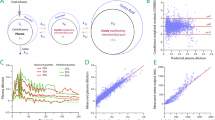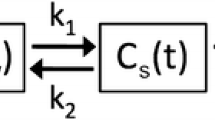Summary
Indicator-dilution curves can be interpreted and analysed by describing the system between injection-and sampling site with a physical model. Till now mainly compartmental and distributed models have been investigated. One feature of distributed models is the possibility to interpret skewness or asymmetry of the curve in terms of a parameter, proportional with the Peclet number, which is a measure of the relative contribution between convection and diffusion in indicator transport. In patients with and without pulmonary edema, we analyzed a number of curves obtained with an intravascular indicator (131I radioiodinated serum albumin, RISA) and a diffusing indicator (tritiated water, THO) over the pulmonary vascular bed. Edema was measured by indexed extravascular lung water and by critical pressure, defined as the difference between pulmonary capillary wedge pressure and plasma colloid osmotic pressure. The significant decrease of the symmetry of the RISA curves with increasing cardiac output we explained by an increasing labyrinth dispersion and increasing turbulence at higher flows.
For normals we found all THO curves to be less skew than albumin curves. This difference diminished and even reversed when the degree of pulmonary edema increased. We suggest a hypothesis for this phenomenon by considering various mechanisms responsible for dispersion and capillary exchange of the indicator during transport from injection to sampling site. In normals the contribution of Taylor diffusion during laminar flow in parts of the circulatory system may be responsible for the greater symmetry of THO curves; with increasing pulmonary edema, transcapillary diffusion of THO causes THO curves to become more skew and even more asymmetric when compared with albumin curves.
Similar content being viewed by others
References
Aris R (1959) On the dispersion of a solute by diffusion, convection and exchange between phases. Proc Royal Soc, London A 252:538–550
Bogaard JM (1980) Interpretation of indicator-dilution curves with a random walk model. Diss. abstr. int.; section C, 1981; thesis Erasmus University, Rotterdam, The Netherlands (with a summary in English)
Caubarrère IF, Ruff P, Duroux C, Gonzales P, de Vernejoul P, Even P (1974) Nouvelle technique de mesure de l'eau tissulaire pulmonaire chez l'homme. Revue Franç de Maladies Resp 2:81–95
Chinard FP, Enns T, Nolan MF (1962) Indicator-dilution studies with diffusible indicators. Circ Res 10:473–490
Chinard FP (1975) Estimation of extravascular lung water by indicator-dilution techniques. Circ Res 37:137–145
Duyl WA van (1976) Theory of the tracer kinetics of diffusable gases through the cerebrum. Internal report, dept. of biological and medical physics, Medical Faculty, Erasmus University, Rotterdam, The Netherlands
Goresky CA (1963) A linear method for determining liver sinusoidal and extravascular volumes. Am J Physiol 204 (4):626–640
Hughes JMB (1977) Pulmonary edema. In: Regional differences in the lung, West JB, ed., Acad Press 381–418
Levitt DG (1972) Capillary-tissue exchange kinetics: an analysis of the Krogh cylinder model. J Theor Biol 34:103–124
Luz PL da, Shubin H, Weil MH, Jacobson E, Stein L (1975) Pulmonary edema related to changes in colloid osmotic and pulmonary artery wedge pressure in patients after acute myocardial infarction. Circ 51:350–357
McDonald DA (1974) Blood flow in arteries, 2nd edn Edward Arnold (Publishers) Itd
Norwich KH, Zelin S (1970) The dispersion of indicator in the cardio-pulmonary system. Bull Math Bioph 32:25–43
Norwich KH (1977) Molecular dynamics in biosystems, Pergamon Press
Perl W, Chinard FP (1968) A convection-diffusion model of indicator transport through an organ. Circ Res 22:273–298
Reth E von, Boogaard JM (1983) Comparison between a two-compartment model and distributed models for indicator-dilution studies (a preliminary investigation concerning the application of a two-compartment model in non stationary flow). Medical Biol Eng and Comp 21:453–459
Schrödinger E (1915) Zur Theorie der Fall- und Steigversuche an Teilchen mit Brownscher Bewegung. Phys Zschr 16 (16):289–295
Sheppard CW (1962) Basic principles of the tracer method. John Wiley and Sons, New York
Sheppard CW, Uffer MB, Merker PC, Halikas G (1968) Circulation and recirculation of injected dye in the anesthetised dog. J Appl Phsiol 25(5):610–618
Sittel CN, Threadgill WD, Schnelle KB (1968) Longitudinal dispersion for turbulent flow in pipes. Ind Eng Chem Fund, 7 (1):39–43
Smith SJ, Hagemeijer F, Gerbrandy J, Esseveld MR (1976) The significance of colloid osmotic pressure and pulmonary capillary wedge pressure in pulmonary edema secondary to acute myocardial infarction. Neth J Med 19:118–126
Smith SJ, Bogaard JM, Hagemeijer F, Rijkmans HJD, Bos G, Hesse CJ (1981) Pulmonary edema in man: comparison of the capillary filtration pressure, quantification by means of the double indicator-dilution method, and clinical observations. Europ Heart J 2:109–116
Staub NC (1974) Pulmonary edema. Physiol Rev 54 (3):678–811
Swan HJC, Ganz W, Forrester JS, Marcus H, Diamond G, Chonette D (1970) Catheterisation of the heart in man with use of a flow-directed balloon-tipped catheter. N Engl J Med 283:447–451
Taylor G (1953) Dispersion of soluble matter in solvent flowing slowly through a tube. Proc Roy Soc (London) A 219:186–203
Taylor G (1954) The dispersion of matter in turbulent flow through a pipe. Proc Roy Soc (London) A 223:446–468
Wise ME (1966) Tracer dilution curves in cardiology and random walk and log normal distributions. Acta Physiol Pharmacol Neerl 14:175–204
Author information
Authors and Affiliations
Rights and permissions
About this article
Cite this article
Bogaard, J.M., Smith, S.J., Versprille, A. et al. Physiological interpretation of the skewness of indicatordilution curves; theoretical considerations and a practical application. Basic Res Cardiol 79, 479–493 (1984). https://doi.org/10.1007/BF01908149
Received:
Issue Date:
DOI: https://doi.org/10.1007/BF01908149




